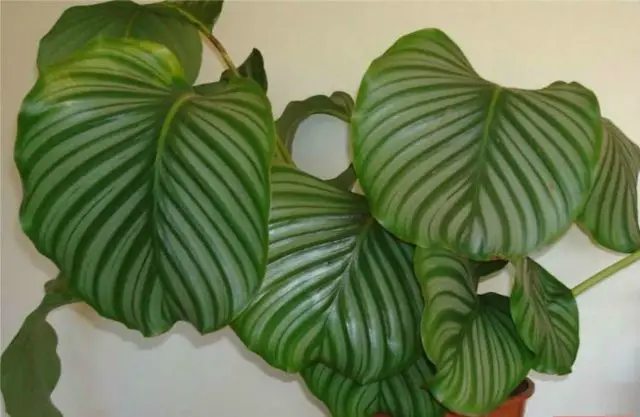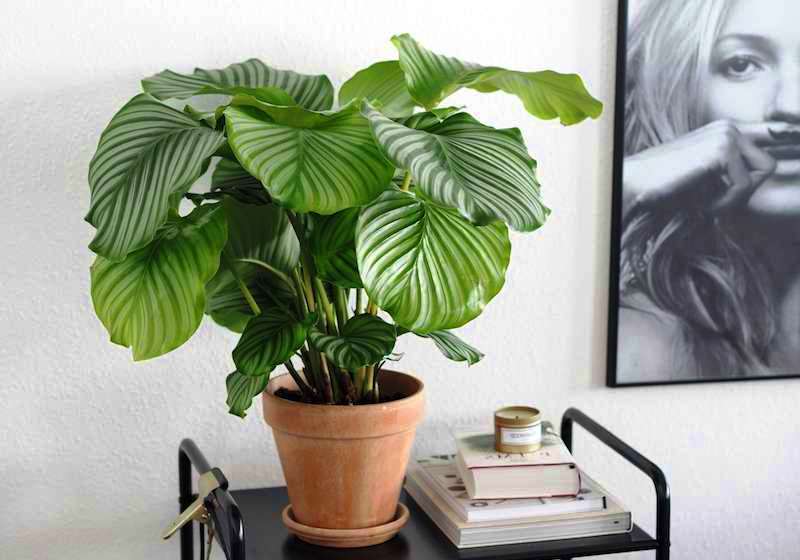Among the huge number of tropical plants “tamed” by humans, Calathea Orbifolia stands out for its incredible mesmerizing color of large rounded leaves swaying on long petioles. For all its aristocratic beauty, among the rest of the calathea, characterized by a capricious character, it is considered one of the most unpretentious, but just like its sisters in appearance, when growing, it requires special conditions.

Calathea Orbifolia: Habitat and Photo
Calathea Orbifolia is a perennial evergreen herb of the Maranth family with unusually colored foliage. Its habitat is the tropical forests of Central and South America, including the Antilles. This plant requires constant moisture, warmth, and the absence of direct aggressive sunlight. In such conditions, it actively reproduces, forming large colonies.
Under natural conditions, Calathea Orbifolia grows up to 60-80 cm in height, and up to a meter in diameter. At home, Orfibolia blooms extremely rarely, it is cultivated for the sake of beautiful, large patterned leaves. Under natural conditions, small pale yellow flowers bloom on a short peduncle, collected in spike-shaped inflorescences and surrounded by green bracts.
The leaves of this species are large, wide, have an almost regular round shape, glossy, thin, with slightly wavy edges, grow swaying on tall, erect petioles. The entire front side of each leaf is decorated with clear symmetrical alternating stripes of dark green and light green with a silvery sheen, almost equal in width, which diverge in both directions from the central vein. The seamy side of the leaves is normal, uniformly green. Thanks to this pattern, the flower looks very impressive and it is impossible not to notice it among other plants.

Calathea Orbifolia home care
Home care for Calathea Orbifolia is no different from caring for any other type of plant of this genus. The only difference is that she is slightly easier than her sisters to tolerate mistakes made during growing, and has a better chance of recovering after eliminating them.
Just like her calathea sisters, Orbifolia categorically does not tolerate three things: direct sunlight, dry air and excessive watering. These indicators must be monitored first of all and try to ensure that they are observed even during the absence of the owners in the house.
Temperature
Moderate temperature in the range of + 18-24 ° C: in winter, the indicators should not fall below + 16-19 ° C, in summer they should not rise above +25 ° C. Drafts and sudden temperature changes are fatal for Orbifolia.
The soil
A slightly acidic, nutritious and loose substrate is exactly what the beauty of Orbifolia needs. It is most convenient to purchase a ready-made soil mixture intended for arrowroot, azalea and cenopoly.
Lighting
Penumbra with enough ambient light. In summer, calathea Orbifolia needs protection from aggressive direct light; in winter, it needs additional diffused lighting to extend daylight hours, bringing conditions closer to natural conditions for its habitat.
Watering
From spring to autumn, the soil must be constantly maintained in a state of moderate moisture, in winter it must be watered after the substrate has dried 3-4 cm deep. For irrigation, use soft, settled water 2-3 degrees warmer than the air temperature in the room.
Humidity
Regular spraying of the leaves is required. If the air in the room is dry, the edges of the leaves immediately begin to dry out. Water for spraying is taken the same as for irrigation. In this case, you need to ensure that water does not accumulate on the leaves.
If necessary, the leaf blades can be gently wiped off by moistening a cotton swab with warm distilled water.
Fertilizers
Top dressing is carried out during the growing season (from spring to autumn) once every three weeks. Special liquid fertilizers are suitable for decorative deciduous plants in a dose slightly less than the manufacturer indicates.
Transfer
Until the plant reaches 4 years of age, it is transplanted every year, then once every 2-3 years. The transplant is carried out in the spring. Calathea must ensure good drainage, its height should be at least 1/4 of the height of the pot.
Calathea Orbifolia Pests
The main enemies of Calathea Orbifolia are mealybugs, scale insects and spider mites. They attack the plant when the air in the room is dry. Measures to combat them are standard for indoor exotics.
calathea orbifolia propagation
Most often, calathea is propagated by dividing the bush. The most convenient time for breeding is the next transplant in the spring. If this is not possible, you can resort to seed reproduction.
To make Calathea Orbifolia feel comfortable and pleasing to the eye, you will have to make an effort. But your work will not be wasted. If you manage to create all the necessary conditions for the beautiful Orbifolia, she will grow with new leaves and become one of the main decorations of the home flower collection.